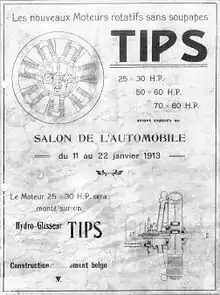Ernest Oscar Tips
Ernest Oscar Tips (born 2 October 1893 in Tielrode, died 10 March 1978 in Brussels) was a Belgian aircraft designer,[1] who co-founded the Fairey Aviation Company in 1915 and its Belgian subsidiary Avions Fairey in 1931.
Ernest Oscar Tips | |
|---|---|
| Born | 2 October 1893 Tielrode |
| Died | 10 March 1978 Brussels |
| Known for | Avions Fairey |
Biography
Early days

Born in Tielrode near Temse in 1893, the youngest of 13 children. His family was active in building mechanical systems such as bicycles. He studied at the Institut St Willebrord, but moved to Brussels at 14 years old to live with his brother after his father had died.[1]
E.O. Tips was already building aircraft ("avion Canard") in 1908, with his brother Maurice. In 1909, they had built a biplane with a rotor. Together, they acquired the licence of the Gnome engine for Belgium and the Netherlands.[2][1]
He fled Belgium at the outbreak of World War I, arriving in England via the (neutral) Netherlands. He learned aeronautical engineering at Short Brothers, and was the first employee of the newly established Fairey Aviation Company that he cofounded in Hayes, Middlesex. In 1917, he released the ship-borne Campania.[2] He was a close friend to Dick Fairey and the Fairey family.[3]
He gained British pilot's license RAC-UK 5904 on May 6, 1918.[1]
Avions Fairey
In 1931, he returned to Belgium to create Fairey's Belgian subsidiary Avions Fairey at the Gosselies airfield. Avions Fairey stands at the cornerstone of Belgium's development of its modern aeronautic industry, the government of Belgium had to negotiate with its UK counterpart to develop the Fairey operations in the flat land.[1] Avions Fairey was created in September 1931 (or 1928[4]) when its UK headquarters sold 25 Firefly II to the Belgian army.[3]
Fernand Jacquet joined the company. In 1933, he assembled the first Tipsy S, powered by a Douglas Sprite 16HP. 19 units of the following model, the S2, were sold. The Tipsy M was a hit and its conception was close to those of modern fighters.[2][1]
Approaching World War II, E.O. Tips organized the company's evacuation to the UK through Saint-Nazaire, France. Tips lost the company's supply at sea, but managed to reach the UK where he held a managing position (Chief Experimental Engineer and Chief Research Engineer of the new helicopter department) at Fairey Aviation. When he returned to Gosselies after the war, the airfield and its buildings had been destroyed. By 1946, E.O. Tips and the team completed the reconstruction of the Gosselies Fairey airfield.[2]
After the war, Tips' two sons joined the company. In 1946, they designed the Tipsy Junior. E.O. Tips he designed the Tipsy Belfair, which held the record for longest distance flight in 1950 (945 km for a -500 kg aircraft) and 1955 (2632 km, same category). In 1953, Avions Fairey received an order of 256 fuselages for the Dutch and Belgian Air Force (as part of the industrial "hunter Program").[2]
In 1955, he became affiliated with the Vieilles Tiges de Belgique.[1]
In 1957, E.O. Tips launched his last aircraft model, the Tipsy Nipper, a light one-seat aircraft that E.O. Tips compared to the "Volkswagen of planes". 62 Tipsy Nipper were produced before E.O. Tips sold the engineering rights when he retired in March 1960.[2][1]
Further reading
- Jacobs, Vincent (2011). Les Avions Tipsy Airplanes (in French). Brussels: Fonds National Alfred Renard.[4]
References
- "Les Vieilles Tiges - Ernest-Oscar Tips, figure de proue de la construction aéronautique belge". Vieillestiges.be. 1955-07-22. Retrieved 2015-08-18.
- Duwelz, Yves (2 April 2013). "Avions Fairey Gosselies". Belgian Wings. Retrieved 2019-09-30.
- Smith, Adrian (2018-04-30). The Man Who Built the Swordfish: The Life of Sir Richard Fairey, 1887-1956. Bloomsbury Publishing. ISBN 9781838609498.
- Ellin, Alex (August 2013). "Les avions Tipsy Airlines" (PDF). Afterburner Book Reviews. Retrieved 30 September 2019.
- "Rue Ernest-Oscar Tips - streets of Charleroi, Walloon Region, Belgium". Maps-streetview.com. Retrieved 30 September 2019.